A Complete Guide to Retail Inventory Management 2025
January 1, 2025
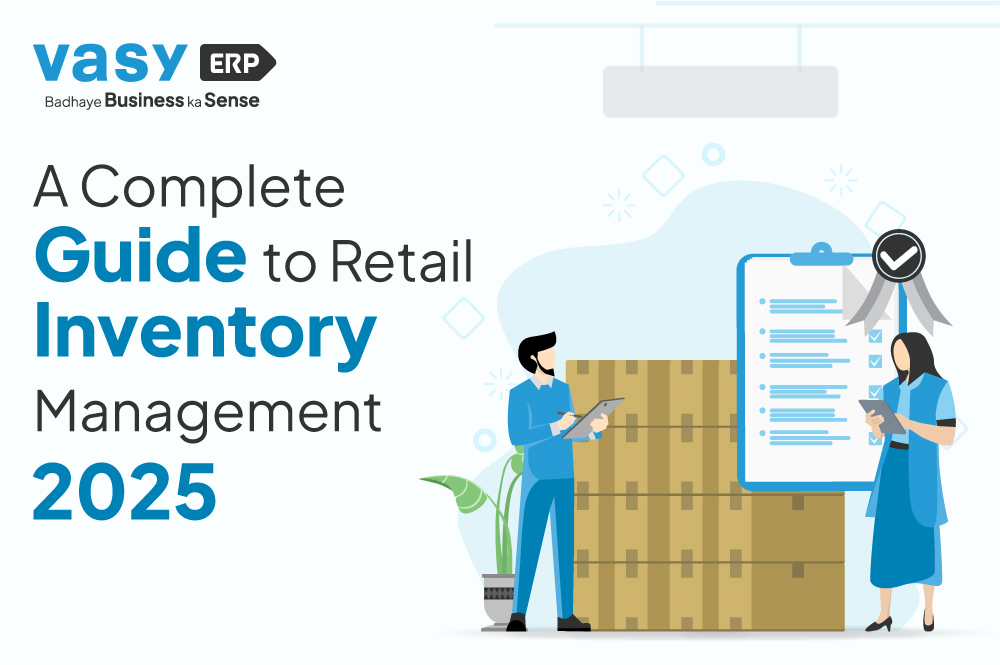
In the past, the concept of inventory referred to the catalog of items available for sale. However, now, inventory is commonly used to describe the actual stock itself. It includes all the items stored, packaged, or moved for selling in a typical business operation. Inventory measurement is typically done in units specific to that particular stock. Inventory plays a crucial role in supply chain management and serves as an asset that can be converted into profits through liquidity.
Examples of inventory can be found in various industries. In a supermarket, inventory includes items like cleaning supplies are inventory. In a footwear store sandals are inventory, for a gift shop, photo frames for sale are inventory and for a stationery store pencil boxes, notebooks, and staplers are the inventory.
Whether you’re a small gift shop owner or a large-scale supermarket, this guide will provide you with the knowledge and insights to efficiently manage your inventory and achieve long-term success.
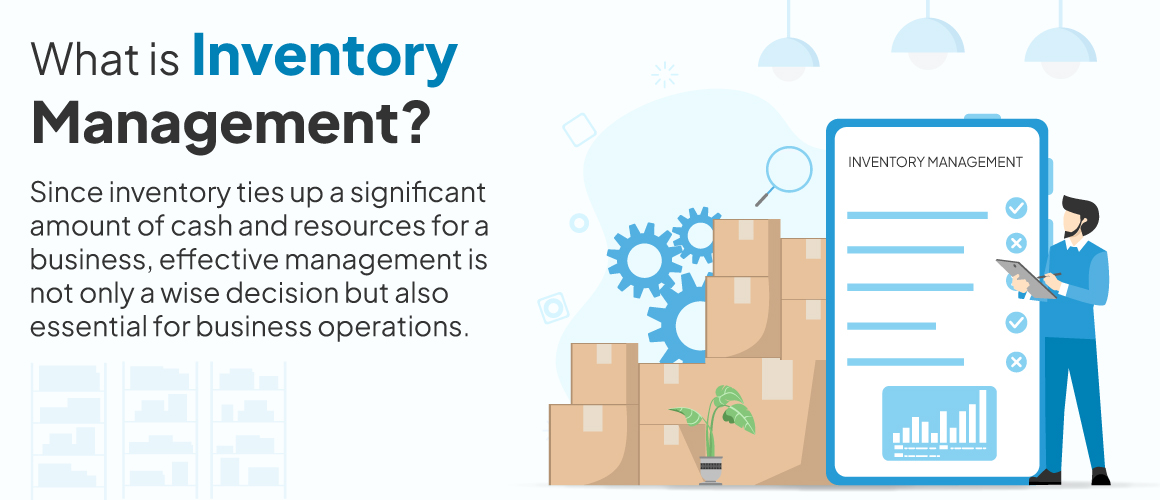
Inventory management, also known as inventory control, are steps, tasks, decisions, and procedures involved in handling stocks, inventory, and the movement of goods within a business. The key objectives of inventory management include maintaining well-organized warehouses, ensuring accurate inventory levels, and tracking logistics efficiently.
| Since inventory ties up a significant amount of cash and resources for a business, effective management is not only a wise decision but also essential for business operations. |
Inventory management aims to increase productivity and customer satisfaction, minimize working capital issues, and optimize the utilization of all stock resources. It serves as the foundation for the entire value chain of products, such as procurement, warehousing sales, or delivery.
Examples of retail inventory management:
In the retail industry, managing various types of inventory is crucial for smooth operations and customer satisfaction. Here are the different types of inventory retailers have to manage:
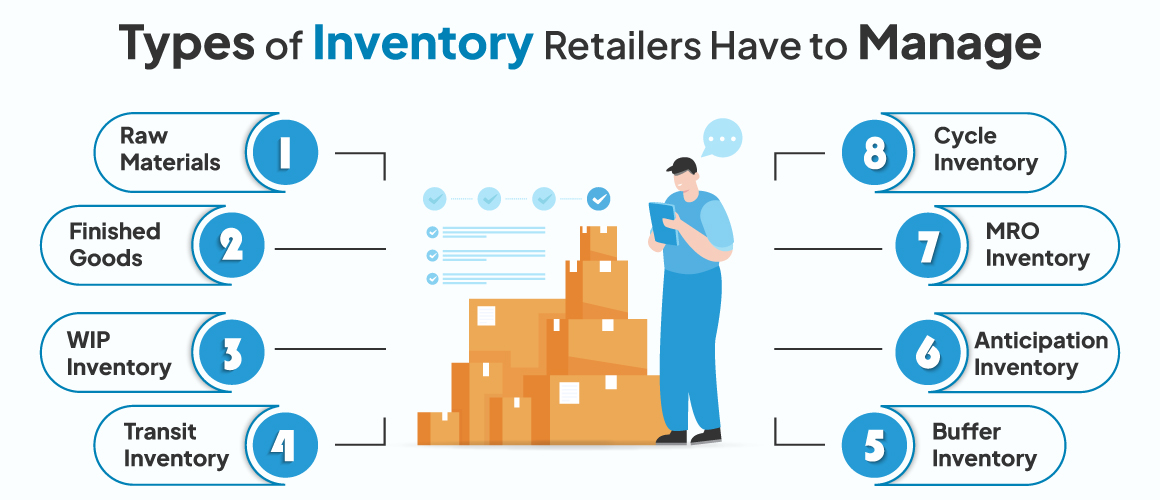
| Buffer Inventory – Buffer inventory, or safety stock, is essential for retailers to manage uncertain demand or supply situations. Retailers must maintain extra inventory to prevent stock-outs due to sudden spurts in demand during seasons, festivities, or holiday-induced demand surge. | Finished Goods – Finished goods in a retail context refer to products that are packaged, and ready for sale. Retailers either directly buy finished goods from wholesalers or create them with their in-house manufacturing. For example, a clothing retailer will have finished goods such as shirts, dresses, and accessories ready for display and sale. |
| Work-In-Process Inventory – Work-in-process inventory for retailers includes products that are in the process of customization for particular preferences by customers. For example, items undergoing alterations (clothing retailers) or items getting added accessories (automobile retailers). | Transit Inventory – Transit inventory, (pipeline inventory), consists of products in transit (delivery) from suppliers to retail stores. For instance, a consumer electronics retailer will have inventory in transit as products are shipped from the manufacturer to the retail outlets/warehouses. |
| Buffer Inventory – Buffer inventory, or safety stock, is essential for retailers to manage uncertain demand or supply situations. Retailers must maintain extra inventory to prevent stock-outs due to sudden spurts in demand during seasons, festivities, or holiday-induced demand surges. | Anticipation Inventory – Retailers accumulate anticipation inventory to meet the increased demand for specific products during anticipated events or seasons. For example, a grocery retailer may stock up on extra inventory of barbecue supplies in anticipation of the summer season. |
| MRO Inventory – MRO (maintenance, repair, and operating supplies) inventory includes items essential for the retail operation but not meant for sale. Retailers may stock MRO inventory such as cleaning supplies, maintenance tools, and employee essentials like uniforms or protective gear. | Raw Materials – Retailers have to procure and store raw materials required for their in-house production of some items or customization needs before they sell those products. For instance, jewelry retailers have to store precious metals and gemstones as raw materials for creating finished jewelry ornaments. |
1. Overstocking
Wrong judgment, over-enthusiasm, or poor demand forecasting may lead retailers to overstock items. It causes unnecessary capital tie-ups or warehouse costs.
2. Understocking
The same reasons that cause overstocking result in understocking too. Like poor demand anticipation, lower enthusiasm, wrong judgment about a stock etc.
3. Improper Inventory Tracking
Sometimes, retailers may not count the warehouse inventory properly, or miss accounting for the inventory in transit or return.
4. Peak season mismanagement
Fast inventory movement from retail (sold goods) and warehouse (incoming or outgoing goods) during high-demand seasons may cause mayhem in inventory management.
5. Order Backlogs
Order backlogs from suppliers can cause inventory issues at retail stores. In such cases, retailers are not in a position to fulfill orders at their retail stores or on their online sites.
6. Inefficient Methods for Returns Management
Goods returned by customers are again part of the inventory. A complicated or inefficient return process without a retail inventory management system will lead to inventory chaos.
7. Technical Issues
Technical glitches in the POS system that retailers use in their retail store or their e-commerce store can cause issues if inventory is not updated in real time.
8. Manual Stock Audit Process
Without an automated stock verification and audit process, retailers may find it extremely difficult to conduct mandatory stock audits and verify their inventory.
9. Barcode and Label Generation
Retailers need a proper system and process for generating barcodes or labels for stock management. However, finding and deploying such a system is a challenge.
10. Inventory Expiry Management
Unsold expired goods are a direct loss to retailers. Also, if by mistake they sell expired goods, it can cause reputational or legal risks.
11. Inventory categorization
Organizing and categorizing multiple variants and SKUs in retail stores can be a challenge if done manually without a system to do so.
12. Retail Inventory Analytics
Retailers may struggle to generate key stock reports and inventory stats about their stock status.
Inventory serves as a valuable financial asset for retail businesses. It plays a vital role in generating consistent revenue and serves as the foundation on which businesses flourish. The absence of efficient inventory management can expose businesses to the risk of losing potential sales and profits.
Below are the top techniques of inventory management that retailers can use to keep their inventory safe, secure and at optimum levels:
Economic order quantity (EOQ) is a widely accepted method in the field of inventory management for estimating the quantity of stock that should be ordered. It is a formula-based equation that calculates the optimal order quantity based on certain inputs.
The inputs include annual demand in units, order costs, and holding costs per year. By inputting these variables into online calculators, EOQ can be easily calculated.
The Just-in-Time technique involves purchasing stocks only a few days before they are needed. This approach helps retailers minimize holding costs, prevent dead stocks, and avoid tying up excessive capital. However, businesses need to have reliable suppliers who can deliver products on short notice to successfully implement this technique.
ABC Analysis is a crucial tool for maximizing profitability by prioritizing more valuable stocks over less valuable ones. You can categorize your stocks into three groups: A, representing the most valuable stocks; B, which falls between the most and least valuable; and C, denoting the least valuable stocks.
This analysis enables you to focus your time and efforts on stocks that generate higher revenue and profitability. It is essential to ensure that the most valuable stocks never run out of stock.
FIFO (First-in First-out) is a technique that involves selling the oldest products first. By prioritizing the products that entered the warehouse first, retailers can maintain a stock of newer products while disposing of older ones.
This method is especially beneficial for perishable goods and fashion-related items such as dairy products and trendy fashion accessories.
The Last-in First-out (LIFO) method proves to be highly effective in situations where you have ordered a product and it happens to arrive last but at a higher cost compared to previous ones. This scenario often occurs when certain products experience sudden price hikes.
In such cases, it is wise to prioritize selling the most recently received product first, as it is the one for which you paid a higher price. You can still retain the cheaper products, making it easier to sell them within the same category.
The replenishment point formula serves as the criterion that many companies utilize to determine when it is time to restock their inventory. This formula acts as a trigger for reordering stock when the inventory reaches its lowest point. To accurately calculate this point, you should regularly conduct audits of its stock.
Replenishment Point Formula= (Average daily usage rate x Lead time) + Safety stock
You may have noticed the presence of batch codes or codes on various products. Batch codes are commonly found on consumer goods. These codes contain valuable information about the product, such as the manufacturing facility, distribution channel, and modes of shipment.
This information proves useful when you need to recall products or identify the source of defective items.
There are two types of demand metrics: independent demand and dependent demand.
Independent demand refers to the demand for inventory that is not influenced by any other variable. On the other hand, dependent demand inventory relies on external factors and variables for its demand. For instance, the demand for accessories for a specific fashion store depends on the number of pieces sold for that particular fashion accessory.
Efficient inventory management involves reducing the waste of time, effort, and materials while enhancing productivity and profitability. Retailers can use the below four lean inventory management techniques to reduce the wastage of employee labor, time, and effort. These methods also save inventory from theft, expiry, spoilage, and slow movement between the warehouse and the retail store.
This approach employs various techniques such as:
1. Kaizen: Continuous improvement (Kaizen inventory management) by reducing waste
2. The Six Sigma methodology: (DMAIC – Define, Measure, Analyze, Improve, Control),
3. Japanese 5S (Sort, Order, Shine, Standardize, Sustain),
4. TIMWOOD (Transport, Inventory, Motion, Waiting, Over-processing, Overproduction, Defect)
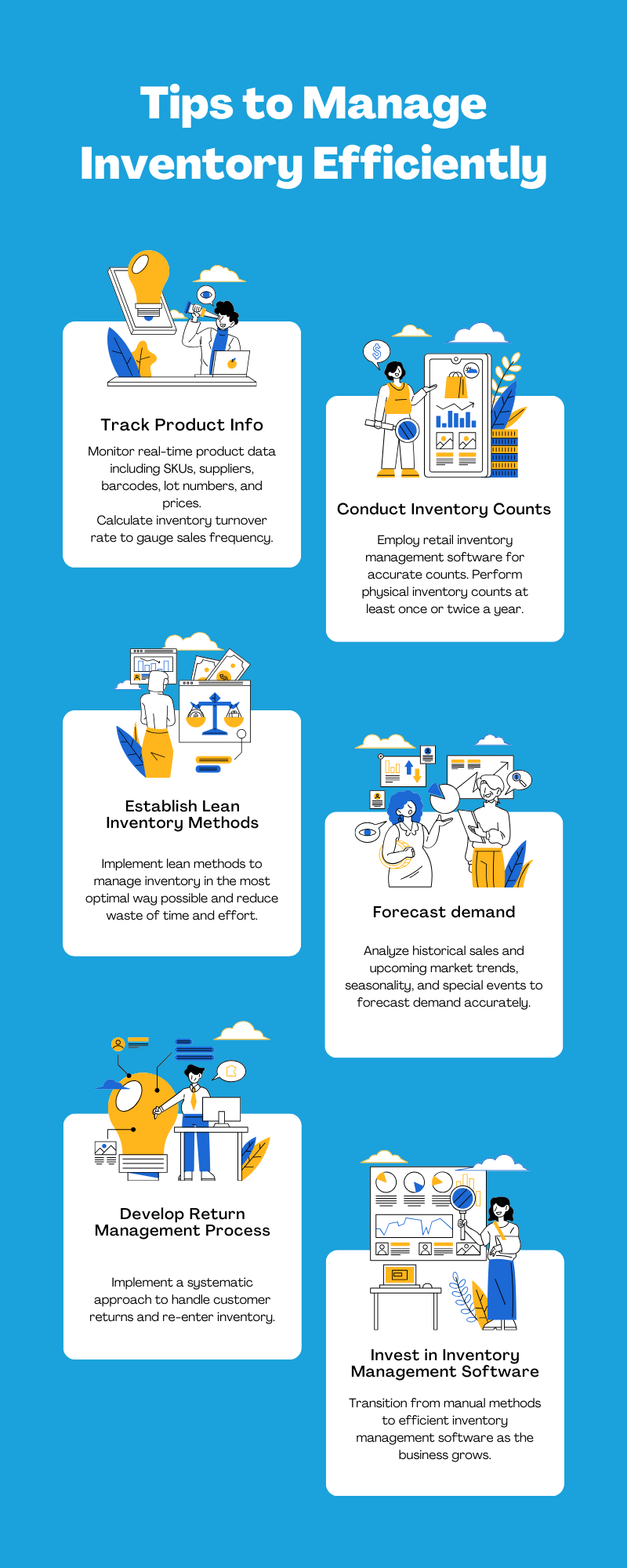
When dealing with inventory management across multiple locations, retail stores, and warehouses, it is crucial to ensure synchronization and real-time updates of stock levels at all sites. Implementing remote data tracking enables staff members to communicate efficiently and collaborate to establish a seamless inventory management system.
To effectively manage your multi-location retail business, there are several strategies you can employ:
Many businesses hesitate to invest in inventory software because they either don’t understand its value or have misconceptions about it. Some businesses choose not to invest in inventory management software because they see it as an unnecessary expense and a financial burden. Others are reluctant to switch from a manual system to an automated one due to their conservative approach. Unfortunately, some businesses fail to recognize the benefits of investing in technology.
Real-time inventory synchronization
This functionality ensures that all inventory transactions are instantly updated. Whenever a customer buys a product from your retail store or places an order on your retail store website, the software makes the changes in the stock count in real time. This system effectively prevents duplicate orders for the same product.
Warehouse management
Utilizing warehouse management features can effectively minimize inventory holding expenses. These features include implementing automated stock picking based on the FIFO principle and generating comprehensive warehouse layout plans, and inventory reports. This system allows retailers to manage multiple warehouses.
Integration with other platforms and web-based services
This software integrates with other popular e-commerce portals like Bigcommerce, Shopify, Amazon FBA, and other cloud-based or web-based services.
Security and Backup
A crucial aspect of inventory management software is ensuring a secure environment for all transactions. Also, it should have the capability to create backups of all data in protected cloud databases that can be accessed remotely.
Scalability
As your business expands and your customer base grows, the software should have the ability to surpass its limitations and scale accordingly.
Accessibility on all devices
To meet the demands of this fast-paced environment, retailers have to access their business on multiple devices- Desktops, laptops, tablets, or even mobile phones to ensure a seamless experience for their customers. Therefore, inventory management software should be compatible with all devices and offer a mobile-friendly version.
Managing Orders
Managing purchase order forms, processing returns, handling payments, generating invoices, editing orders, setting prices, and managing back orders.
Identifying Products and Categorizing Products
Using barcode scanning, RFID, and other wireless methods to identify products. Categorizing products involves the software creating multiple labels to organize them.
Managing Multiple Locations
This feature allows for real-time updates on inventory and synchronizes information from multiple warehouses.
Grouping Inventory
Easily locate and manage inventory by categorizing and classifying it. This feature helps identify similar items and group them together.
Forecasting Demand
The software should have the capability to forecast demand for each product based on historical data, current business trends, and future prospects.
Supplier Management
Enables users to effectively manage suppliers, providing a list of all suppliers in one place. It records transactions with specific suppliers and tracks the closest and most cost-effective options for inventory restocking.
Analytics and Reports
The software should provide a detailed analysis of the inventory metrics and present other retail analytics reports about all important aspects of the inventory.
User-friendly
The software should prioritize ease of use, with an intuitive interface that allows for effortless navigation. It should not burden users with unnecessary complexity or cause frustration.
Dependable customer support
Given that inventory management software has multiple features, users may need to seek technical support from the vendors. The software provider must provide reliable and prompt customer support to address any issues that may arise.
Making even small efforts to eliminate obstacles in the inventory management system can result in significant cost savings. Implementing best practices such as drop shipping, utilizing multiple warehouses, wave picking, integrating with third-party systems, investing in cloud-based inventory management software, establishing return management SOPs, and utilizing inventory forecasting can enable your retail business to grow in a positive direction.
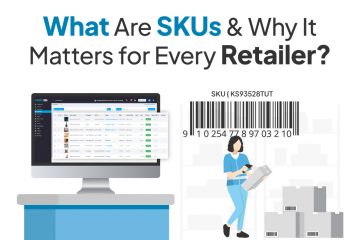
SKUs or stock keeping units are a blend of characters a...
July 27, 2025

Being a retailer, do you ever struggle to maintain the ...
May 6, 2024
